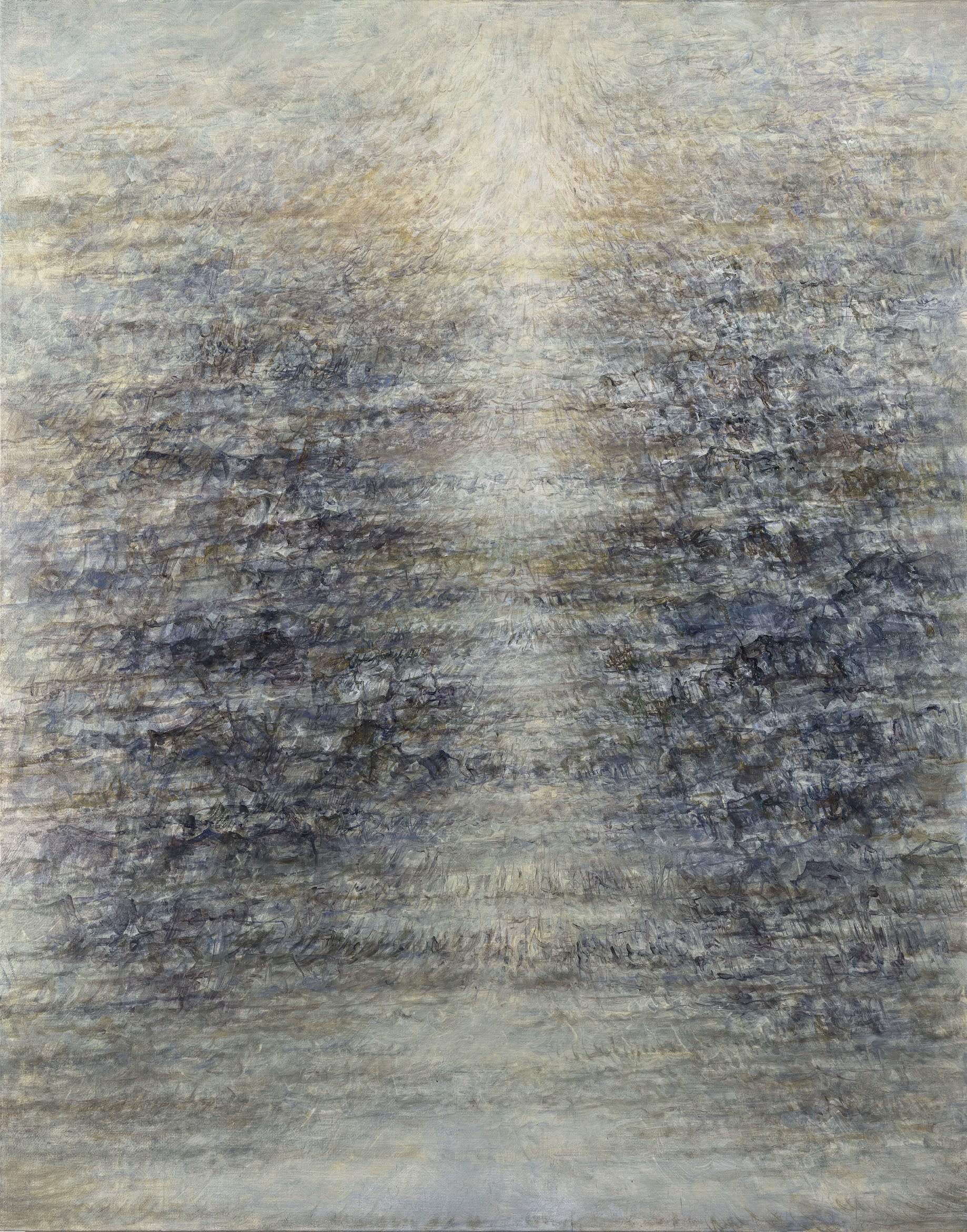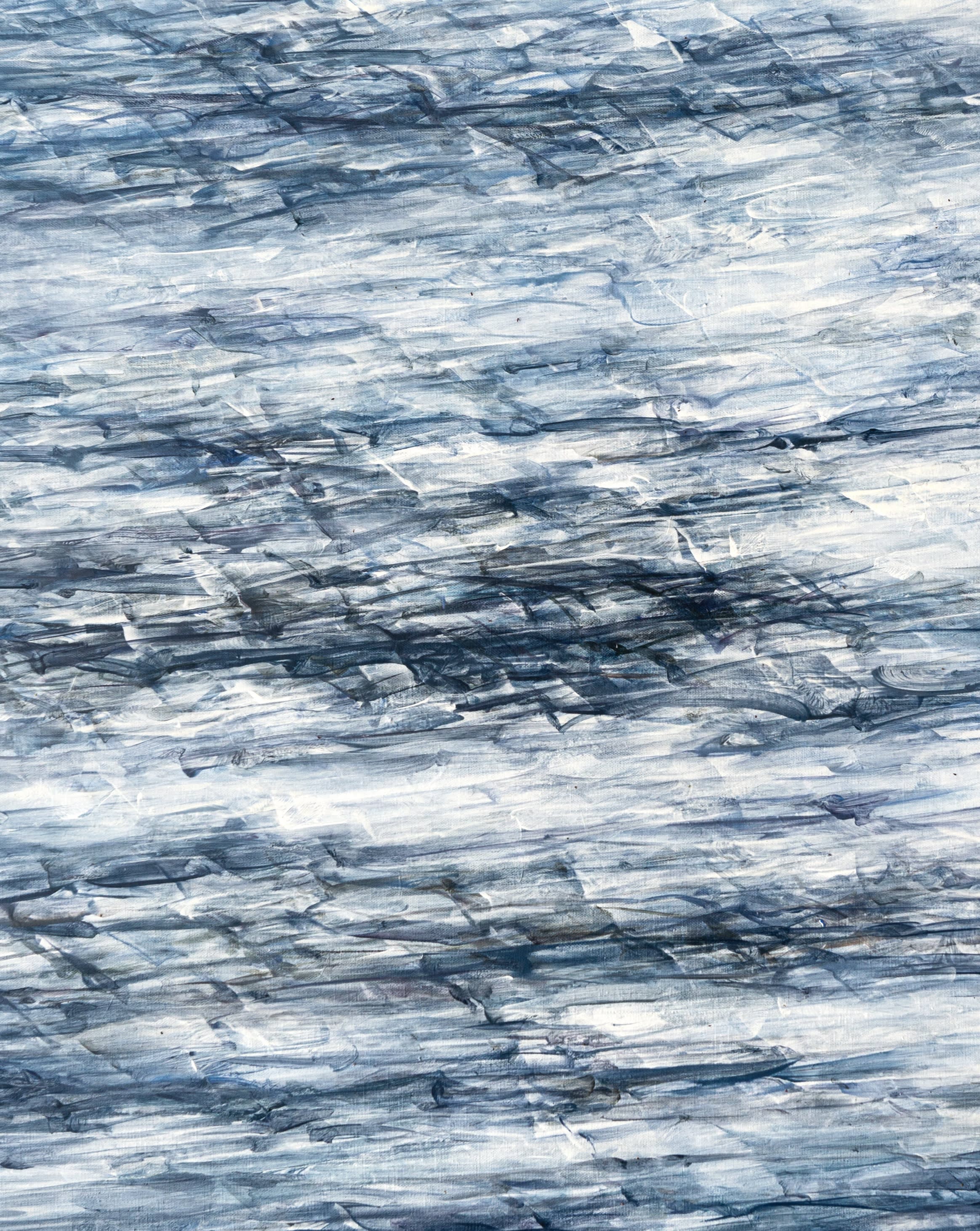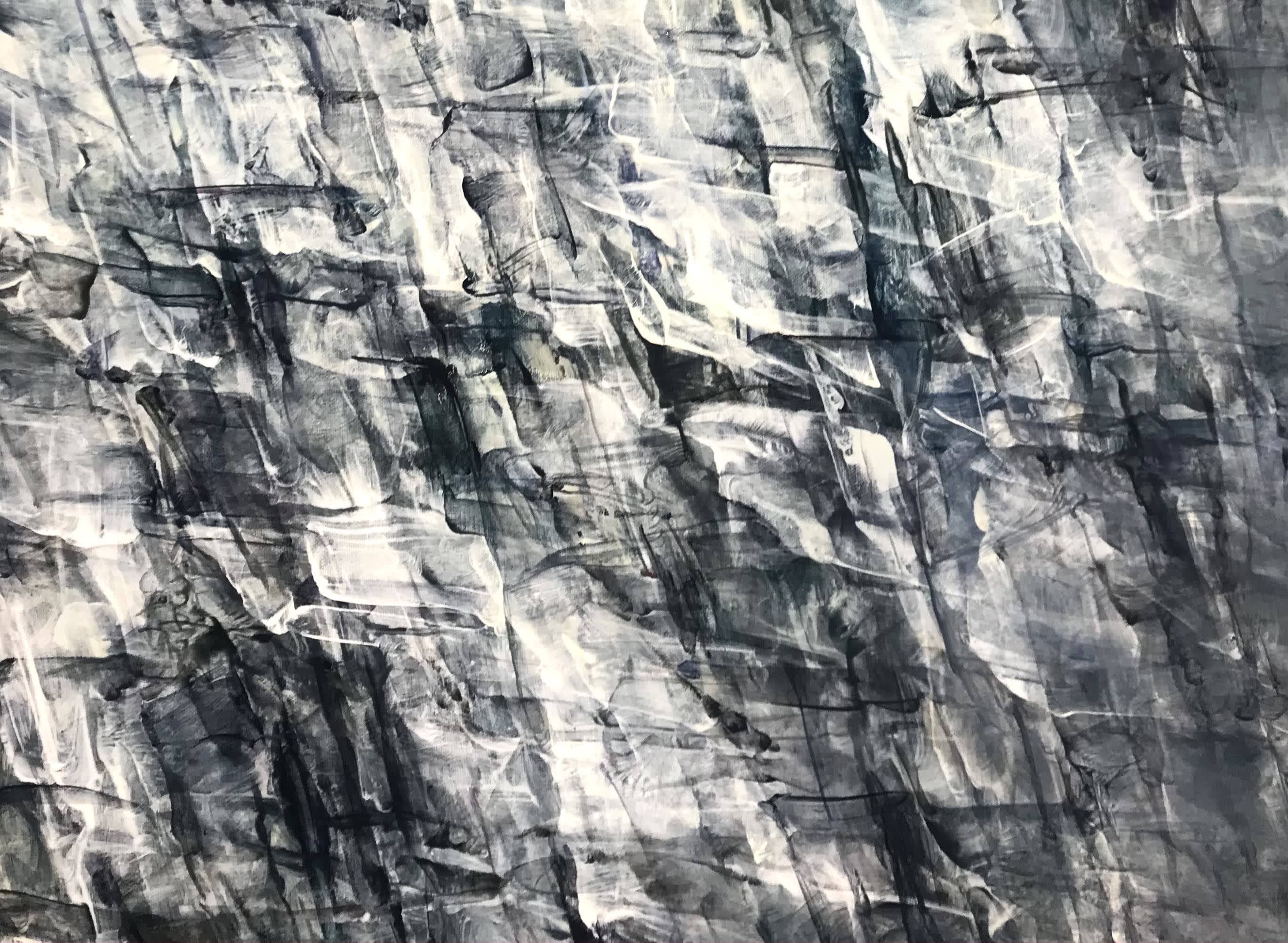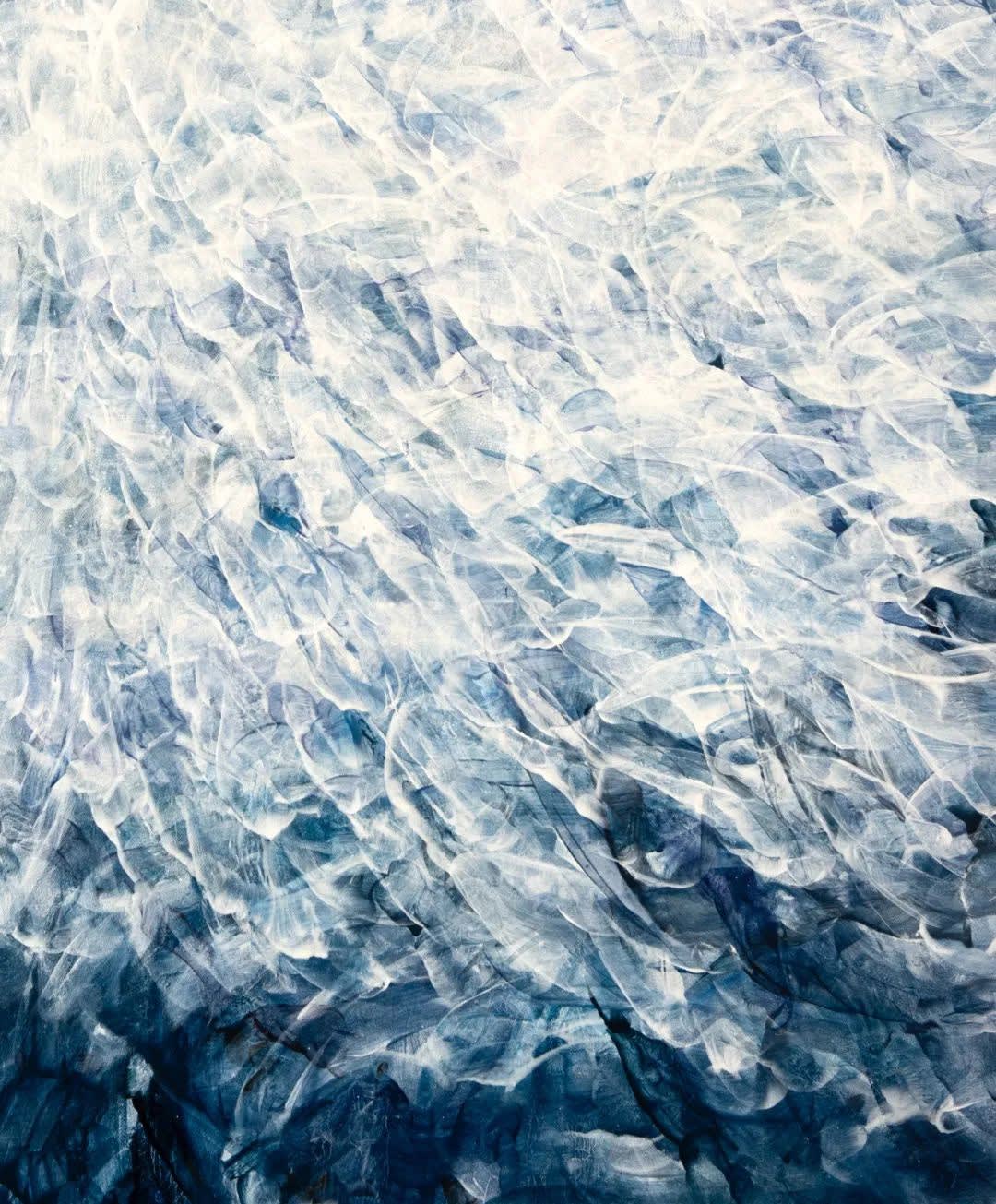
When viewing paintings by Liu Guofu, there appears to be a slow dispersion on canvas, and smooth energy flows out of the flat surface. Such a condition may associate with blandness. However, deep and great power seems to release in slow motion. Although the emotional catharsis is not as strong and spectacular as that of Romanticism - which utilises terrifying beauty to astonish the onlooker, conversely, the majestic movement is in accord with the universe, flowing towards the eternal and the ideal. This is the painting of entropy, a cosmological concept that determines the transition between order and chaos.
The concept of entropy stemmed from the field of physics. It is a thermodynamic quantity representing the unavailability of a system's thermal energy for conversion into mechanical work. If entropy increases, the total energy would gradually dissipate. However, it was Erwin Schrödinger, who, in 1943, during the lecture
What is Life,imparted and applied entropy to the field of biology. He interpreted entropy as the degree of disorder or randomness in the system. Namely, the rate of structure-energy configuration corresponds with the value of entropy in this way: A positive Entropy increase suggests the transition from order to disorder, while when the negative entropy appears, chaos would gradually transform into order.
[1]Flower No. 14 (detail), 2021, Oil on canvas, 160 x 120 cm
Forms of life correlate with birth, ageing, illness and death, and so does the process of creating art. Guofu's painting illustrates such a dispersed state, synthetically combining the state of creating, the form of art and the pattern of life. His painting is of entropy. The artist internalised the external movements by certain principles. Through his brush, the visual presentation embodies such a change of order.
Regarding the study of Aesthetics, there are three ways to observe and interpret the art of Liu Guofu:
principle,
skill and
trend. These three aspects are derived from Han Feizi, the great synthesiser of classical Chinese philosophical thinking. Here they can be used according to the triangle mode of public value, proposed by Mark H. Moore, professor at the JFK School of Government at Harvard University. Moore asserted
value,
competence and
support as three key measurements.
[2] The three can be paired with the traditional Chinese value system in examining Guofu's art. That is to say, the value of Guofu's abstractness lies in the principle of painting, his artistic competence is reflected by his pictorial skills, and the support manifested the trend of images.
Cold Mountain No.15 (detail) , 2022, Oil on canvas, 190 x 150 cm
The Principle of Painting:
When Filippo Brunelleschi, the innovative Renaissance architect, envisioned the installation of the grand dome on Santa Maria del Fiore, he did not only pursue the spectacle but also the principle of space.
The issues that Guofu wanted to address in front of the canvas were how to reorganise the visual and rediscover ideas from the age of antiquity. Which has become more urgent, particularly in this age of chaos and mediocrity, when society is muddled in a stupefying situation. His images project an outstretching principle, within which a well-functioning colour-brushwork field has been built. Regarding the composition, the seemingly monochrome colour is constructed by thousands of nuanced strokes and transformed into a field of heart, reflecting the painter's artistic judgement. The traces were made from the uniformity of the artist's heart and hands. These are the tail of time. Although, the images in detail appear to be lustrous and bizarre, all are under the painter's control; as a result, the overall tone is sombre, rigorous and faithful. Guofu has organically decontextualised the line and ink-effect of Chinese calligraphy into his painting of abstractness. One of the high principles in Chinese art is 'To learn from nature and to gain the source of heart'. Ancient thinkers in China tended to convey their ideas via symbols based on aesthetic objects. Namely, to take the external semblance as the starting point of observation, then to analyse, interpret, synthesise, and internalise, for emotional expression.

Open Space No. 2023-2, 2023, Oil on canvas, 190 x 150 cm
Confucius sighed in front of a river, 'The passage of time is just like the flow of water, which goes on day and night.'
This is what Confucius unearthed when observing the patterns and semblance of rivers and mountains – the change of time cannot be altered by the will of human beings. The interference of entropy in energy flow is eternal. The humanistic emotion was imparted to the cruelty of time.
Guofu has created a resemblance of potential energy within the limited flat surface. Viewing from different angles, one can find the uniformity of the principle is in accord with the universe. There are analogies between the rhythm of clouds, mists, mountains and waters and the brushstrokes. Only by following such a principle could the picture represent the natural sense of mindflow. Such a principle, with a decisive depiction of entropy embodies the value of Guofu's painting.
 Pervasion No. 39 (detail), 2021, Oil on canvas, 160 x 120 cm
Pervasion No. 39 (detail), 2021, Oil on canvas, 160 x 120 cm
The Skill of Art:
When Leonardo da Vinci was trying to portray a subject, he hesitated in capturing the perfect posture, and it was precisely this pondering that electrified his wild imagination and intoxicated his beautiful soul. A way to represent time was what he endeavoured to achieve.
The marvels of Guofu's painting lie in his particularity in perfecting the details. His meticulous image-making skill enables the artist to render the surface with the notion of revitalisation. First, the canvas is made with a subtle texture. Then colours were applied and carefully washed for creating an effect of translucency. In this case, the chiaroscuro is not restrained by laws of linear perspective; instead, with the echoes from various light sources, the lines and colours are imparted with aromatic vitality. Then the artist could capture the decisive moment, posture and charm by applying the primer. Therefore the spirit of the image can be unearthed, and the best possible configuration can be conveyed. Such a skill testifies the competence of Liu Guofu as a professional artist.
Song Di (c. 1015-1080), a famous artist and theorist of the Northern Song dynasty, described a scene of painting, the procedure of which is very similar to Guofu's:
First, a cracked wall is required. Then a piece of plain silk can hang on this broken wall. Before drawing, the artist would observe it in the morning and evening. Through the semi-transparent silk, the cracks form zigzag lines, from up to down, all resemble patterns of mountains and waters. The artist could ponder the images, envisioning the high ones as mountains, the low ones as waters, the pit part as valleys, the holes as creeks, the more visible part as the foreground, and the less visible part as the background. With the guidance of the imagination and artistic skill, the painter can capture the coming and going images of humans, birds, grass and trees. Then these pictures can be projected naturally. The final result would seem to be made by the universe, instead of by human hands. This is the so-called live brush.
[3]
It is due to the professional skill of Guofu, that he has developed the eye to discover great forms of painting, the mind of plasticity and the skill of painting lights. In his painting, human imagination and the creativity of the almighty merged organically in one. Thereafter, the painting is full of live brush. Even in his old age, Leonardo could not forget the first sight he laid on the water flow in the Arno valley when he was young. He never stopped drawing the marvellous view of the infinite energy and ephemeral patterns of water flow. Unfortunately for Leonardo, the incarnation of the Renaissance man, even his observation is constrained by a middle-range field of view. Therefore he was perpetually perplexed by the randomness of energy dispersion. If one can look at the water flow from a distance as far as from outer space, or via a close-up view through a microscope in slow-motion, the flow may appear flat and diffusing, conveying entropy change. Guofu's skilfulness lies in that he can use abstract pictorial language, and masterfully transform the figure on canvas. This is precisely his artistic competence.
 Cold Mountain No.7 (detail) , 2018, Oil on canvas, 180 x 130 cm
Cold Mountain No.7 (detail) , 2018, Oil on canvas, 180 x 130 cm
The Trend of Image:
Nearly all sciences explore the patterns of life and nature, and only those, who experienced and witnessed the ebbs and flows, can distinguish the false glory and fabricated notions, so that the internal and external trends can be synced.
Guofu's pictures are the visualisation of his cognition. Admittedly the artist lives in the secular world. Therefore he cannot prevent his heart from being enslaved by the body. Nevertheless, as a creator, he can make and erase images with endless possibilities by his unbridled mind within the limited dimension of the universe. His heart commands the painting hand, and his will flies alongside the lines. The status is similar to Zhang Yanyuan's description of Wu Daozi, one of the greatest masters in ancient China: 'The notion is precedented the brush; even if the picture is exhausted, the meaning would be everlasting, because the brushwork extends the wilful mind.'
[4]
Zhuangzi once postulated: 'Our life is limited by boundaries, but cognition has none.' Artworks are made by humans, whilst the invaluable ones will surpass the boundary of mortality.
Painting is the trace of the human spirit, gradually dispersing in the dust of history. When the sun sheds the first golden ray on the shore of souls, it is there waiting for the fisherman to return. Alas, there was once a momentous moment in history, a fisherman told the first Chinese poet, Qu Yuan, who was obsessed with patriotism: 'The sane one will not be stopped by objects; instead, one will follow the trend of the world.' After listening to such kind and wise advice, the poet still could not be persuaded. Soon after, the fisherman oared the boat, leaving. Meanwhile, the poet, jumped into the river, sinking.
[5] Guofu is situated in the contemporary world full of conflicts and clashes. He also cannot help but feel the sorrow of the decadence of the motherland or even the apocalypse of the entire world. Sadly, it is easier to relocate a mountain than to remove human obsession. Only by staying calm, collected and bland, can one widen the horizon of cognition. This is a revelation of the famous idiom: 'One can't show high ideals without simple living; One can't have lofty aspirations without a peaceful state of mind.' Tragically, the one who coined this phrase cannot be liberated from his political ambition. Zhuge Liang, one of the most brilliant minds, stopped thinking when societal actuality exhausted his final breath. After that, it can be said, the state of blandness is like a lofty cold peak, nearly impossible to arrive at. Nevertheless, the image trend Guofu created, realised such a blandness.
No matter how hard an object is, under the influence of entropy, it will deconstruct from order to disorder, from an entity to a myth, from an upsurge to a dispersion.
Such a dispersion can be recognised as a potential trend, an artistic phenomenon. Wu Dayu, the forerunner of modern art in China, once posited: 'The beauty of the potential trend, is like the mass of non-entity and is as abstract as geometric architecture. Both marvellous music and choreography have fortuitous and ineffable rhythms. They all have the beauty of potential trends.'
[6]
Liu Guofu is an artist, which means he is a creator, who endeavours to communicate with his audience. They shared the rhythms of breath and fate. If, in painting, the space of imagination is blocked by physical walls, the trend will also be constrained by objects, therefore, it cannot evolve with the world.
Nearly a hundred years ago, the forebearer of Chinese art modernisation, Lin Fengmian, outlined these areas for the later generation to explore: 'mediating the arts of the East and West; introducing western Art; categorising Chinese art; creating future art.'
[7] It may appear to be very simple. However, only few Chinese artist can achieve it. Liu Guofu has carefully compared the traditional ink painting (aura, rhythm, thought, scene, brushwork and ink ) and Western oil (plasticity, colouring and chiaroscuro), and then captured the essence of image-making. Unlike those who superficially borrowed Western pictorial languages and grafted them into piles of nonsense, Guofu has pursued truth instead of prettiness. This particular persistence in art is invaluable and indispensable.
The image Guofu created, illustrates a trend, that unifies his cognition and action, mediates the world's tendency and individual choices, and combines the visible and the ineffable. It is the blandness that supports the weight of his artistic conception.
 Open Space No.68 (detail), 2021, Oil on canvas, 120 x 90 cm
Open Space No.68 (detail), 2021, Oil on canvas, 120 x 90 cm
Conclusion:
Last but not least, admittedly, art is interpretable while ineffable. What is legible can be explained with reason. Meanwhile, the indescribable is the undercurrent myth. Such a myth in art is not to befuddle the audience; instead, it exists due to the perceptual activities in human minds. It is the combination of principle, skill and trend. It is also the complacency of value, competence and support. These images are like glimmers during the sunset, dusts in the galaxy, flowing in the sea of mind, floating in the field of the heart. They have surpassed reason in the world of sense, taking the leap of soul. When we meditate in tranquil surroundings, it is like deducing entropy, disseminating energies from the inner world to outer space. The artist transferred the order and disorder of nature into another visual world via his bodily language, so that the trace of creativity can be extended and the legend of life can be circulated.
Click
here to visit the
In Praise of Blandness exhibition page.
[1] Erwin Schrödinger, 1944, What is Life? The Physicist’s Approach to the Subject – With an Epilogue on Determinism and Free Will, Cambridge University Press.
[2] Mark H. Moore, 2013, Recognising Public Value, Harvard University Press, p. 105.
[3] Shen Kuo, 11th century, Dream Pool Essays, Northern Song dynasty.
[4] Zhang Yanyuan, 9th-10th centuries, Notes of Past Famous Paintings, Tang dynasty.
[5] Sima Qian, Records of the Grand Historian, 2nd-1st centuries BC.
[6] A Collection of Wu Dayu’s Art, 2020, ed by Shou Chongning and Li Dajun, The Commerical Press.
[7] Lin Fengmian, 2014, Catalogue Raisonné, Vol. 5, China Youth Press, pp. 290-291




 Pervasion No. 39 (detail), 2021, Oil on canvas, 160 x 120 cm
Pervasion No. 39 (detail), 2021, Oil on canvas, 160 x 120 cm Cold Mountain No.7 (detail) , 2018, Oil on canvas, 180 x 130 cm
Cold Mountain No.7 (detail) , 2018, Oil on canvas, 180 x 130 cm Open Space No.68 (detail), 2021, Oil on canvas, 120 x 90 cm
Open Space No.68 (detail), 2021, Oil on canvas, 120 x 90 cm
